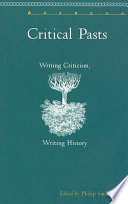 | Brian A. Wren - 2000 - Liczba stron: 440
...advantage dressed, What oft was thought, but ne'er so well expressed, Something, whose truth convinced at sight we find, That gives us back the image of our mind.27 What Pope hoped to do for*his readers, Isaac Watts aimed to do for congregations. From their... | |
 | John Sitter - 2001 - Liczba stron: 322
...Thought, but ne'er so well Exprest." But if the reader merely goes on with Pope to complete the sentence - "Something, whose Truth convinc'd at Sight we find, / That gives us back the Image of our Mind" - a deeper meaning begins to emerge, one in which learning is a form of recollection, the remembrance... | |
 | Fredric V. Bogel - 2001 - Liczba stron: 280
...speak, "already read" and require, as a result, only to be re-cognized. In consequence, the text is "Something, whose truth convinc'd at sight we find / That gives us back the image of our mind" (299-300). Such a text is scarcely "other" at all, and Pope's lines appropriately fuse truth and reader... | |
 | Greg Clingham - 2002 - Liczba stron: 238
...True Wit is Nature to Advantage drest, What oft was Thought, but ne'er so well Exprest, Someth1ng, whose Truth convinc'd at Sight we find. That gives us back the Image ol our Mind. (lines 297-3oo) Johnson's criticism effectively assimilates, moralizes, and broadens Dryden's... | |
 | Jeffrey Wainwright - 2004 - Liczba stron: 248
...advantage dressed, What oft was thought, but ne'er so well expressed; Something whose truth convinced at sight we find, That gives us back the image of our mind. But the eighteenth-century neo-classical tradition Pope represents sees poetry as at heart rhetorical:... | |
 | Philip Smallwood - 2004 - Liczba stron: 228
...to Advantage drest, What oft was Thought, but ne'er so well E^prcst, Something, whose Truth convmc'd at Sight we find, That gives us back the Image of our Mind. (lines 297-300)7 — but the major historians of eighteenth-century criticism cannot seem to reveal... | |
 | Angus Fletcher - 2004 - Liczba stron: 350
...completely orthodox command that we should not "scan" God. Equally, it controls his elegance and point: True wit is Nature to advantage dress'd; What oft was thought but ne're so well express'd. The dance of the couplet depends upon the pirouette, as if in its poetic form... | |
 | Sandra K. Dolby - 2005 - Liczba stron: 220
...poem "An Essay on Criticism," Alexander Pope gives us the handy couplet that recognizes this process: True wit is nature to advantage dress'd, What oft was thought, but ne'er so well express'd. Some three hundred years later, writers are still eager to borrow pieces of wisdom that have already... | |
 | James T. Como - 2005 - Liczba stron: 516
...appeal is expressed by these lines from Pope in An Essay in Criticism. Something, whose truth convinced at sight we find, That gives us back the image of our mind. Yet, as appropriate as they are in so many ways, I have thought again. In writing about his beloved... | |
 | Christian Kortmann - 2006 - Liczba stron: 324
...advantage dressed, / What oft was thought, but ne'r so well expressed, / Something, whose truth convinced at sight we find, / That gives us back the image of our mind." Romano 1979 Romano 1979 zeigt, in welchen Strukturen literarische Artefakte altern. Dass Sagan „unser... | |
| |